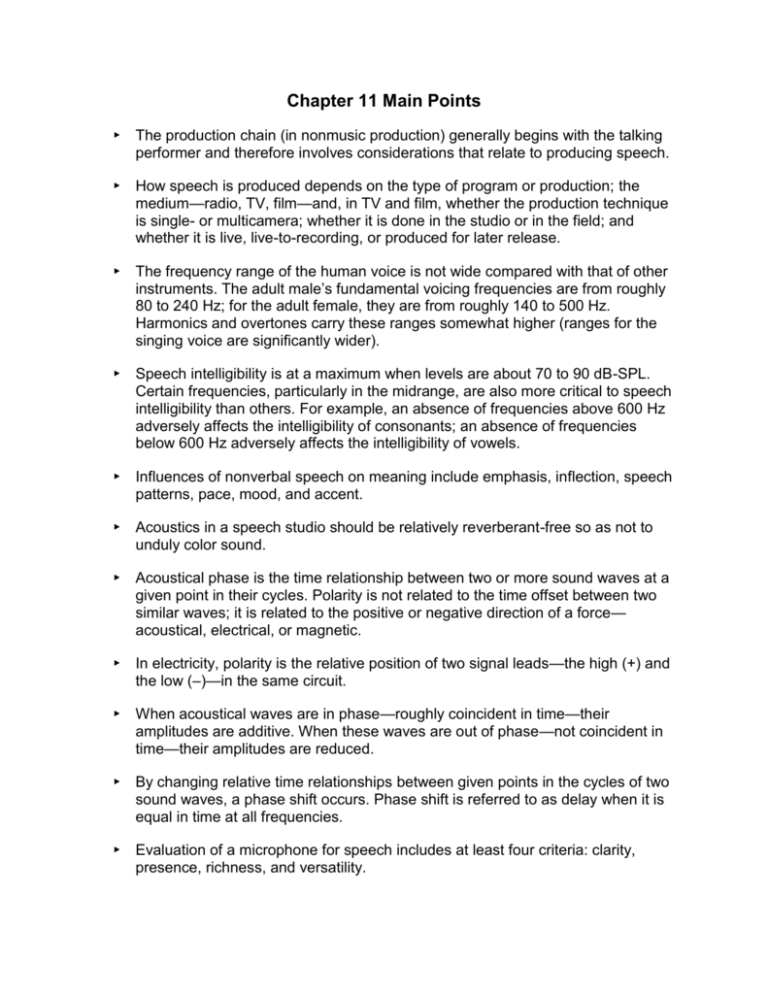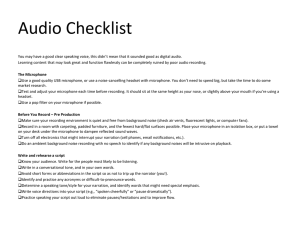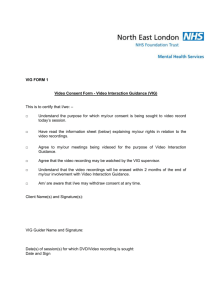Chapter 11 Main Points
advertisement

Chapter 11 Main Points ► The production chain (in nonmusic production) generally begins with the talking performer and therefore involves considerations that relate to producing speech. ► How speech is produced depends on the type of program or production; the medium—radio, TV, film—and, in TV and film, whether the production technique is single- or multicamera; whether it is done in the studio or in the field; and whether it is live, live-to-recording, or produced for later release. ► The frequency range of the human voice is not wide compared with that of other instruments. The adult male’s fundamental voicing frequencies are from roughly 80 to 240 Hz; for the adult female, they are from roughly 140 to 500 Hz. Harmonics and overtones carry these ranges somewhat higher (ranges for the singing voice are significantly wider). ► Speech intelligibility is at a maximum when levels are about 70 to 90 dB-SPL. Certain frequencies, particularly in the midrange, are also more critical to speech intelligibility than others. For example, an absence of frequencies above 600 Hz adversely affects the intelligibility of consonants; an absence of frequencies below 600 Hz adversely affects the intelligibility of vowels. ► Influences of nonverbal speech on meaning include emphasis, inflection, speech patterns, pace, mood, and accent. ► Acoustics in a speech studio should be relatively reverberant-free so as not to unduly color sound. ► Acoustical phase is the time relationship between two or more sound waves at a given point in their cycles. Polarity is not related to the time offset between two similar waves; it is related to the positive or negative direction of a force— acoustical, electrical, or magnetic. ► In electricity, polarity is the relative position of two signal leads—the high (+) and the low (–)—in the same circuit. ► When acoustical waves are in phase—roughly coincident in time—their amplitudes are additive. When these waves are out of phase—not coincident in time—their amplitudes are reduced. ► By changing relative time relationships between given points in the cycles of two sound waves, a phase shift occurs. Phase shift is referred to as delay when it is equal in time at all frequencies. ► Evaluation of a microphone for speech includes at least four criteria: clarity, presence, richness, and versatility. ► Factors that influence a microphone’s effect on the sound of the speaking (and singing) voice are its sound quality, directional pattern, and mic-to-source distance. ► The closer a mic is to a sound source, the warmer, more detailed, denser, more oppressive (if too close) the sound, and the closer the listener perceives the speaker to be. ► The farther a mic is from the sound source, the less warm, less detailed, thinner (if there is little reverberation) the sound, and the more distant the listener perceives the speaker to be. ► Performing speech generally involves either the voice-over (VO)—recording copy to which other sonic material is added—or dialogue. Voice-over material includes short-form material, such as spot announcements, and long-form material, such as documentaries and audiobooks. ► Speech sounds are harmonically and dynamically complex. ► Voice acting involves taking the words off the page and conveying meaning, making them believable and memorable. ► Among the considerations of a voice actor in bringing the appropriate delivery to copy are voice quality, message, audience, word values, and character. ► Prerecorded voice collections provide a variety of words, phrases, sayings, and vocal sounds to use in the absence of, or to supplement, a voice actor. ► When hundreds of voice-overs may be required for such projects as video games and online dictionaries, automation is necessary and software programs are available to handle these needs. ► Recording speech begins with good acoustics. Mediocre acoustics can make speech sound boxy, oppressive, ringy, or hollow. ► Producing a solo performer and a microphone is a considerable challenge: there is no place to hide. ► Among the things to avoid in recording speech are plosives, sibilance, breathiness, and tongue and lip smacks. ► Mic-to-source distance depends on the strength, resonance, and intensity of the performer’s delivery, but it should be close enough to retain intimacy without sounding too close or oppressive. ► In terms of recording levels, recording is usually done flat so that there’s no sonic “baggage” to deal with in the mix or if the recording has to be continued on another day or in a different studio. Any signal processing done during recording is typically quite minimal. ► In producing a voice-over, if ambience is important to the overall delivery, it may be necessary to record it separately, after the performer finishes recording, by letting the recorder overroll. ► One time-consuming factor often overlooked in recording speech is the editing. If mistakes are made, rather than leave them for the editor, try for a trouble-free retake. ► Making the performer comfortable is of the utmost importance. ► To avoid generating unnecessary noises the clothing a performer wears should be cotton rather than synthetic fabrics and be loose-fitting for better comfort than tightfitting clothes. ► Doing a voice-over when elements such as background music and sound effects are to be added later requires care to ensure that, when mixed, these elements do not interfere with the intelligibility of the copy. ► In mixing audio for a spot announcement, fading the music after it is established to create a hole for the announcement and then reestablishing the music at its former full level is called a donut. ► Using compression, in moderation, enhances the spoken word by giving it clarity and power. ► Backtiming is a method of subtracting the time of a program segment from the total time of a program so that the segment and the program end simultaneously. ► Deadpotting, also called deadrolling, is starting a recording with the fader turned down all the way. ► Three types of narration are direct, indirect, and contrapuntal.








